-
Exploring the XenCenter workspace
-
The Navigation Pane
-
-
-
-
This content has been machine translated dynamically.
Dieser Inhalt ist eine maschinelle Übersetzung, die dynamisch erstellt wurde. (Haftungsausschluss)
Cet article a été traduit automatiquement de manière dynamique. (Clause de non responsabilité)
Este artículo lo ha traducido una máquina de forma dinámica. (Aviso legal)
此内容已经过机器动态翻译。 放弃
このコンテンツは動的に機械翻訳されています。免責事項
이 콘텐츠는 동적으로 기계 번역되었습니다. 책임 부인
Este texto foi traduzido automaticamente. (Aviso legal)
Questo contenuto è stato tradotto dinamicamente con traduzione automatica.(Esclusione di responsabilità))
This article has been machine translated.
Dieser Artikel wurde maschinell übersetzt. (Haftungsausschluss)
Ce article a été traduit automatiquement. (Clause de non responsabilité)
Este artículo ha sido traducido automáticamente. (Aviso legal)
この記事は機械翻訳されています.免責事項
이 기사는 기계 번역되었습니다.책임 부인
Este artigo foi traduzido automaticamente.(Aviso legal)
这篇文章已经过机器翻译.放弃
Questo articolo è stato tradotto automaticamente.(Esclusione di responsabilità))
Translation failed!
The Navigation Pane
The XenCenter® Navigation pane provides various options to view and access managed resources. The following navigation buttons provide a quick way to view and manage your resources:
- Infrastructure
- Objects
- Organizations Views
- Saved Searches
- Notifications
The following sections provide an overview of the buttons in the Navigation pane:
Infrastructure
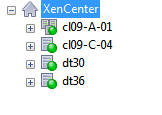
This view is the default view. The Infrastructure view displays a tree view of the resources by their physical location. It provides a list of servers, VMs, templates, and storage resources by the pool or the server to which they belong.
Objects
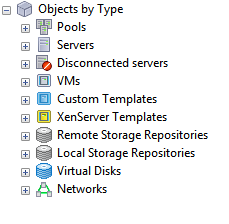
Select Objects to see a list of the resources by categories such as pools, servers, VMs. Expand the nodes to view items in each category.
Organization views
XenCenter allows you to group resources for ease of management. By default, XenCenter provides the following types of Organization Views:
- Objects by Folder
- Objects by Tag
- Objects by Custom Field
- vApps
- VM groups
Objects by folder
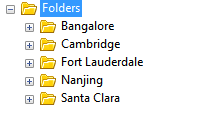
Select this option to view your resources by folders. You can create folders to group your resources by location, function, resource type, and so on
Note:
Organizing resources into a folder is conceptual, and not physical. The resources are note physically moved to a folder if you choose to group them by Folders.
For detailed information about creating and managing folders to organize your resources, see Using Folders.
Objects by Tag
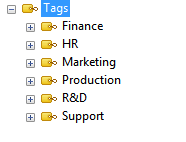
Select this option to view your resources by the tags that you have previously defined. Tags are labels that you specify to view resources based on the criteria that you define. A single resource can contain multiple tags. For example, a server with the tag ‘Production’ can also be tagged as ‘R&D’.
For detailed information about creating and managing tags in XenCenter, see Using Tags.
Objects by Custom Field
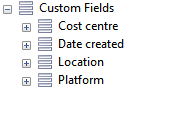
Select this option to view your resources by the customized fields you have previously defined. XenCenter enables you to add custom fields to your resources and provide a value to effectively manage your resources. You simply add a custom field to a server, VM, or any other resource in the pool, then give it a value. You can then use custom field values when building search queries.
For information on creating and using custom fields, see Using Custom Fields.
vApps
Select this option to view your VMs by the vApps they belong to. A vApp is a group of one or more VMs which can be managed as a single entity. For detailed information about vApps, see Managing vApps.
VM groups
Select this option to view your VMs by the VM group they belong to. A VM group is a set of one or more VMs whose placement behavior is defined by the rules of the group. For more information, see Manage VM groups.
Saved searches
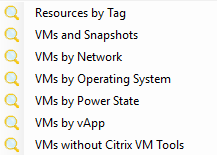
Click this button and select an option from the list to view resources that match the search criteria. By default, XenCenter includes a few saved searches that allow you to search your resources. You can create and add your own query to this list at any time.
For detailed information about the Search functionality in XenCenter, see Searching Resources.
Notifications
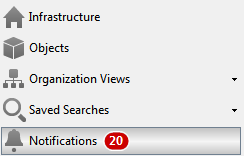
Click this button for the Notifications view. The Notifications view enables users to see all notifications in a centralized location and perform specific actions to address them. It contains Alerts, Updates, and the Events view.
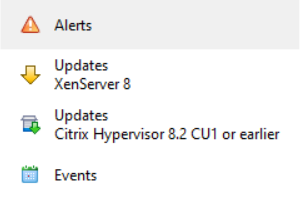
Alerts
The Alerts view displays a list of system alerts generated by XenCenter. You can filter the alerts by various options and take specific actions to address the alerts. For detailed information, see XenCenter Alerts.
Updates
XenCenter issues notifications about available updates for your hosts and pools under the Updates tabs. The Updates tabs are split into XenServer 8.4 updates and Citrix Hypervisor updates. For more information, see Update your XenServer hosts or Update your Citrix Hypervisor hosts.
Events
Select this option to see a summary of all events in your current XenCenter session. For detailed information, see XenCenter Event Log.
Share
Share
In this article
This Preview product documentation is Cloud Software Group Confidential.
You agree to hold this documentation confidential pursuant to the terms of your Cloud Software Group Beta/Tech Preview Agreement.
The development, release and timing of any features or functionality described in the Preview documentation remains at our sole discretion and are subject to change without notice or consultation.
The documentation is for informational purposes only and is not a commitment, promise or legal obligation to deliver any material, code or functionality and should not be relied upon in making Cloud Software Group product purchase decisions.
If you do not agree, select I DO NOT AGREE to exit.